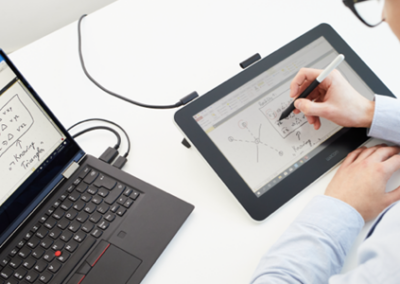When you’re teaching online, a starter activity is a great way to get your learners quickly engaged with the lesson. It gives them something to do straight away, with no need to ask you questions. That leaves you free to take the register, check everyone is prepared for the lesson, and get started.
Did you know your Wacom pen tablet is the perfect tool for lesson starters? We’ve got 15 great ways you can use it for live online lessons, or in your classroom.
Why use a lesson starter?
Lesson starters create a buffer between students arriving and the lesson beginning. When they join, instead of wondering what to do, or getting bored, they can get straight into an activity you’re screen sharing. Because it requires little or no explanation, you’re free to deal with technical problems and class management.
Starter activities are a handy way to recap prior learning with spaced retrieval practice. Don’t feel you have to stick with work from the last lesson. Look further back and use your starter to recap work from the previous week or term.
Using a starter helps students see how lessons connect to each other. Rather than learning in isolation, the starter reminds them that this lesson is part of a sequence. This is especially useful if you’re using a blended learning approach with both classroom teaching and eLearning routinely used.
What makes a good lesson starter?
There are thousands of activities you can use for lesson starters, but effective ones all share the same common elements.
They are:
- Focused on learning: Avoid activities that are fun but pointless
- Engaging: To get students focussed quickly and interested in the learning
- No explanation needed: To stop students overwhelming you with questions
Your Wacom pen tablet makes the learning personal. Use it to edit a worksheet, write questions, or draw diagrams you have specifically designed for the needs of your students. You’ll love how flexibly you can use it online or in the classroom.
You could recap prior knowledge through your starter activity. They are useful for reminding students of key vocabulary they often forget. Alternatively, look forward and pose a deep, open-ended question that will get them thinking ready for the lesson ahead. Just make sure it doesn’t require subject knowledge you haven’t taught yet.
15 lesson starter ideas
There are hundreds of great starter activities to choose from. Just make sure they deliver the learning your students need, rather than simply filling their time. We’ve selected fifteen of our favourites here that will all work perfectly with your pen tablet.
1: Guess the drawing
No need to be an artist, just draw a simple picture related to key learning and get your students to record their ideas about it. Ask them to write three questions they can ask to find out more.
2: Cloze procedures
Type up a simple missing word passage and ask your students to fill in the blanks. Struggling learners could have a vocabulary bank to choose from displayed on the screen. When they’re ready, handwrite in the answers.
3: Ask a question
The ultimate in quick starters. Use your pen tablet to write an open-ended question and display it on your screen. Use your pen to record student responses when you start the lesson.
4: Riddles and puzzles
Handwrite a series of questions or clues using your pen tablet to give your students a fun challenge. You could add simple drawings, highlight words, and insert diagrams to give them clues.

5: Matching activities
Display a series of vocabulary words and their matching definitions. Use your pen tablet to draw the connecting lines when you mark them together.
6: ‘Only Connect’ game
Taking inspiration from the popular UK TV show, create a 4×4 grid. Fill it with four groups of four words randomly arranged. Students have to guess which words belong together. Use your pen tablet to highlight the connections.
7: Odd one out
Display three images or words and ask students to decide which is the odd one out and why. Use your pen to record their ideas, with different colours to group the suggestions together.
8: 3,2,1
Handwrite three, two, and one things you’d like your students to write, e.g. in a maths lesson they could write three prime numbers, two multiples of 12, and one integer that is a factor of 30.
9: Quiz
Display quiz questions that touch on previous units of work. Mark them together with your class using your pen tablet to write in the answers.
10: What could it be?
Display an image you’ve drawn over with your pen tablet. Slowly uncover it using the erasure tool. Students write their guesses or type them in the chat bar.
11: Word search
A simple way to practice key vocabulary. Display a word search for your students to complete and highlight the words for them to mark off.
12: Crossword
Create a crossword grid and write simple clues for each word. Mark it together, writing in the answers for them to see.
13: Word games
Scramble the letters that make a key vocabulary word. Students try to solve the anagram and for bonus points, see how many other words they can make with the same letters.
14: Current news
Display a recent news event and ask students to record their opinion and questions they’d like to ask. Use your pen tablet to record each response with different coloured pens to show the connections between them.
15: Ranking
Display different sentences, ideas, or words and ask your students to rank them in order of importance, in a list or Diamond 9. Your pen tablet lets you write their ideas and number rank them when you mark together.
The benefits of a Wacom pen tablet for starter activities
With a pen tablet, you can recreate that familiar whiteboard experience for you and your students. It’s a comfortable break from typing and lets you handwrite as you talk, removing that disconnect of typing up ideas. It’s easy to capture students’ thoughts and make a visual copy of your online conversation.
Pen tablets are a flexible tool. You can draw, write, annotate, and highlight existing resources. That saves you wasting time creating new versions of worksheets to suit your students. Wacom is compatible with all your favourite programs, making it easy to switch between them naturally whilst you teach.
Final thoughts
Using a starter activity for online teaching is a smart move. It frees you up to greet students and sort those little technical hiccoughs we all experience when teaching live. Because the tasks are self-explanatory, learners can join the class and start working independently, reducing the amount of interruptions.
Without a starter, you struggle to manage students invariably joining your class at different times. You waste precious minutes repeating the learning objectives and re-explaining tasks, whilst other students sit bored waiting to move on. A starter activity means, when you’re prepared to teach, everyone is on task, engaged, and ready to learn.
Learn more about promotions and Wacom Deals here: https://estore.wacom.com/de-DE/







